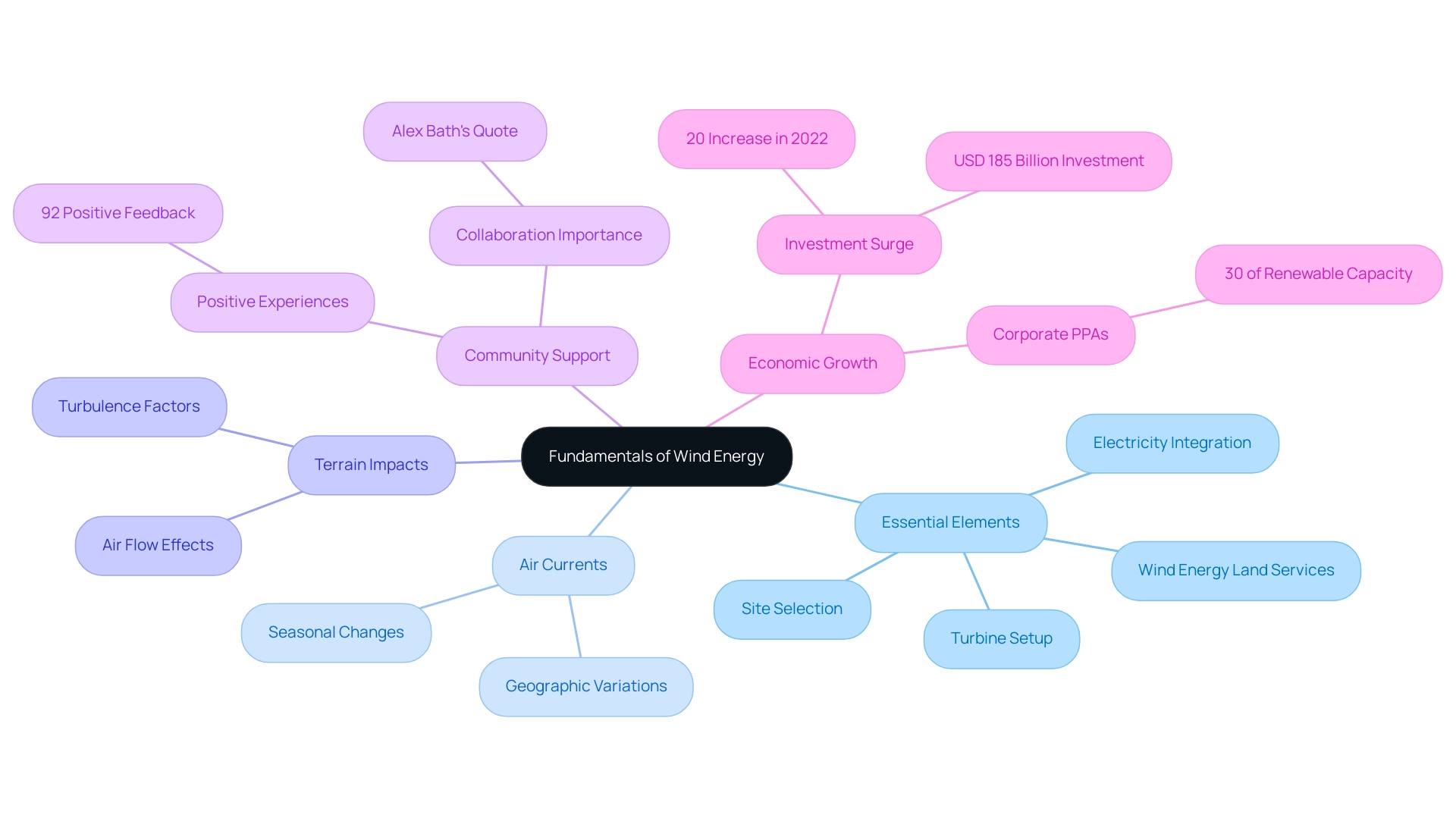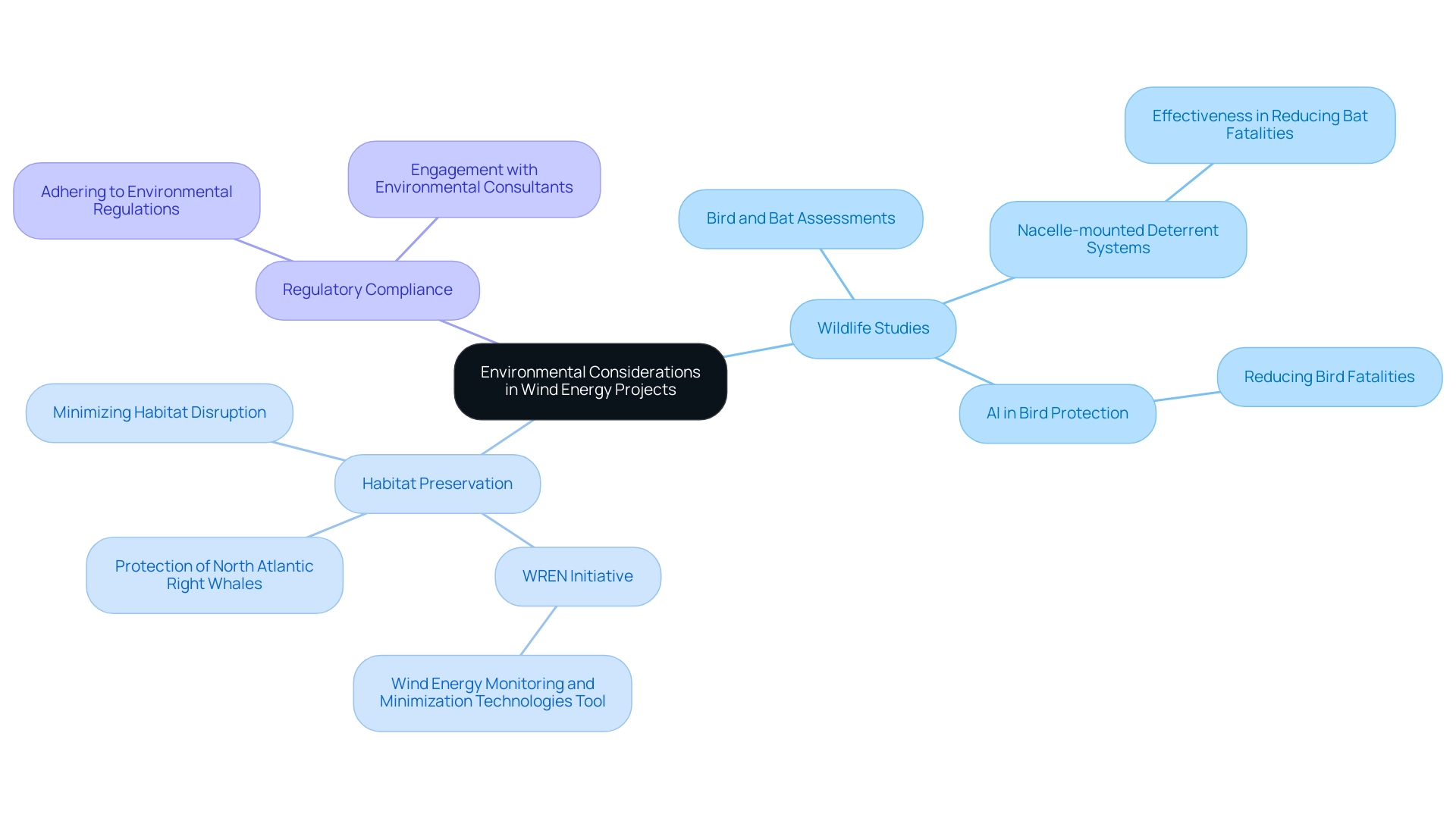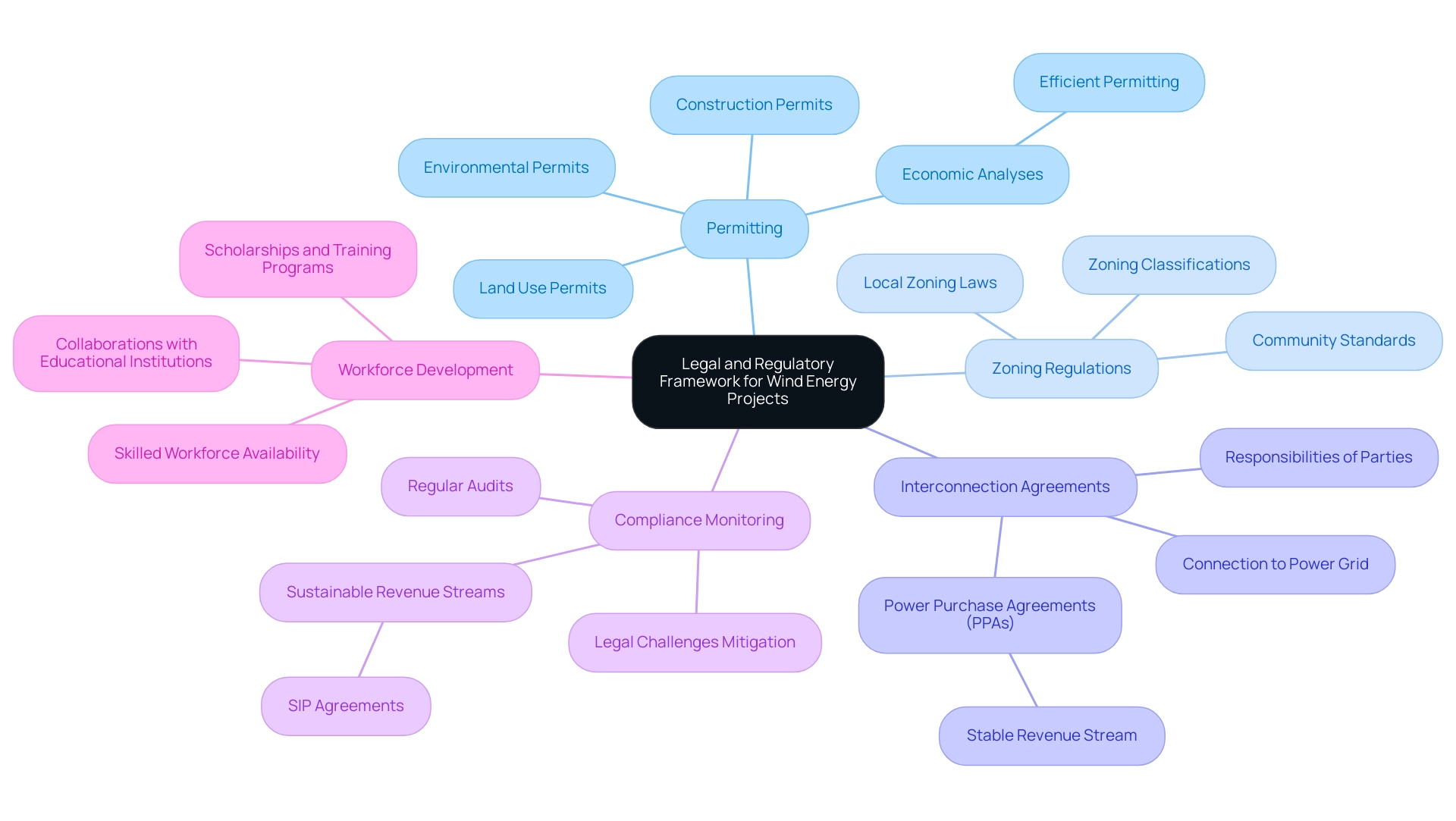Introduction
The burgeoning field of wind energy presents a transformative opportunity for sustainable power generation, yet it is not without its complexities. As developers embark on wind energy projects, a multitude of factors must be meticulously considered to ensure success.
- From the strategic selection of suitable sites
- The integration of advanced technologies
- Navigation of legal frameworks
- Stakeholder engagement
Each aspect plays a pivotal role in the overall efficacy of wind initiatives. Understanding the intricate interplay of these elements is essential for harnessing the full potential of wind energy, thereby contributing to a greener future.
This article delves into the fundamental components of wind energy projects, exploring best practices, technological innovations, and the importance of community involvement in fostering a supportive environment for renewable energy development.
Fundamentals of Wind Energy: An Overview
Air power is captured by turbines that transform the kinetic force of air into electrical power. The achievement of a renewable energy initiative relies on several essential elements, including:
- Wind energy land services
- The meticulous choice of appropriate locations
- The setup of turbines
- The efficient incorporation of generated electricity into the power grid
A notable element affecting the effectiveness of these initiatives is air currents, which can differ depending on geographic location and seasonal variations.
Terrain also plays a vital role, as it can affect air flow and turbulence, impacting turbine performance. Furthermore, closeness to existing infrastructure, such as transmission lines, can enable smoother execution and lower costs. Recent statistics indicate that 92% of individuals residing within five miles of a turbine report positive or neutral experiences, reflecting the community's acceptance of renewable initiatives; this acceptance underscores the importance of site selection and community involvement in ensuring success.
Alex Bath, Communications Director, highlights, 'Community support is essential for the sustainability and success of energy initiatives, as it encourages collaboration and reduces opposition.' Understanding these fundamentals allows project developers to make informed decisions regarding wind energy land services and project execution, ultimately leading to more successful outcomes. Furthermore, the private sector's activity in renewable energy has increased significantly, with corporate power purchase agreements (PPAs) making up 30% of all renewable capacity contracted in 2022.
As investment in turbine generation surged by 20% in the same year, reaching a remarkable USD 185 billion, rebounding from a slowdown in 2021, it is evident that ambitious government targets and supportive policies are driving growth in this sector. This momentum is anticipated to persist, making it essential for developers to remain aware of progress in renewable technology and efficiency factors.

Navigating Land Management Services for Wind Energy Projects
Efficient wind energy land services for energy initiatives are crucial for guaranteeing successful execution. This process encompasses several key activities:
-
Site Selection and Acquisition: The initial phase involves identifying and securing suitable land parcels, which requires a comprehensive assessment of wind resource potential, environmental impacts, and existing land use.
Current trends indicate that strategic site selection significantly affects viability and performance.
-
Title Research: Thorough title research is essential to confirm clear ownership rights and identify any encumbrances on the property. Utilizing AI-powered title research tools can improve efficiency and accuracy, minimizing potential delays in timelines.
-
Right-of-Way Management: Negotiating access rights for construction and maintenance activities is crucial. This includes a thorough understanding of easements and ensuring compliance with local regulations, which can help avoid legal disputes and enhance operational efficiency.
-
Stakeholder Engagement: Interacting with local populations, landowners, and regulatory bodies is essential for project success.
Recent initiatives emphasize how communities can work together with turbine developers to establish educational programs and scholarships for local residents, facilitating pathways into jobs in turbine construction and maintenance. This proactive strategy encourages backing for renewable initiatives and reduces possible conflicts. Furthermore, county commissioners have established a stabilization fund utilizing around $3.2 million from the building permit fees gathered, highlighting the financial elements of land management in these initiatives.
As Joelynn Schroeder from NREL remarked, 'Effective land management is vital for the success of renewable resources, ensuring that all stakeholders are aligned and compensated fairly.' This highlights the importance of understanding the roles of various landowners. For instance, the case study on types of landowners involved in renewable energy initiatives shows that compensation structures vary based on land use, with turbine hosts receiving the most significant payments, while adjacent and non-participating landowners may receive lesser or no compensation.
By mastering wind energy land services, developers can not only streamline their operations but also enhance the likelihood of achieving favorable outcomes. The interaction of these activities has a crucial impact on the overall success of renewable initiatives, making it essential for developers to prioritize effective land management strategies.
Environmental Considerations in Wind Energy Projects
Wind energy projects have a profound impact on local wildlife, habitats, and ecosystems, necessitating comprehensive environmental assessments to identify and mitigate potential effects on flora and fauna. Key considerations include:
-
Wildlife Studies: Rigorous assessments of bird and bat populations are vital, as turbines can pose significant risks to these species.
Models predicting flight paths and associated risks are being developed to aid in effective planning and operational adjustments. Notably, advancements such as nacelle-mounted deterrent systems have demonstrated effectiveness, with Chris Hein from the National Renewable Energy Laboratory stating,
Nacelle-mounted deterrent systems have been shown to reduce overall bat fatalities by 50% and more.
Furthermore, the adoption of artificial intelligence technologies in the renewable energy sector shows promise in protecting birds from turbine collisions, highlighting innovative solutions being implemented.
-
Habitat Preservation: Implementing strategies to minimize habitat disruption during both construction and operational phases is essential to sustain local biodiversity. The ongoing Working Together to Resolve Environmental Effects of Wind Energy (WREN) initiative, initiated in 2012, has established the Wind Energy Monitoring and Minimization Technologies Tool to support wind energy land services by cataloging various environmental monitoring and mitigation technologies.
Furthermore, with fewer than 400 North Atlantic right whales left, the urgency of wildlife protection in relation to wind energy initiatives cannot be overstated.
-
Regulatory Compliance: Adhering to local, state, and federal environmental regulations is a mandatory aspect of development.
Engaging with environmental consultants ensures that all requirements are met and that the initiative aligns with conservation goals. By prioritizing these environmental considerations, developers can significantly enhance the acceptance and sustainability of their initiatives, fostering a positive relationship with surrounding ecosystems.

Legal and Regulatory Framework for Wind Energy Projects
Wind energy initiatives operate within a complex legal and regulatory landscape that encompasses several critical requirements:
- Permitting: Developers are required to apply for a variety of permits, including land use, environmental, and construction permits. A thorough understanding of the local permitting process is essential, as it can significantly influence timelines and overall feasibility. For instance, economic analyses from the National Renewable Energy Laboratory reveal that efficient permitting can streamline initiation and reduce costs, ultimately enhancing viability.
- Zoning Regulations: Adhering to local zoning laws is essential for ensuring that the proposed initiative aligns with land-use plans of the area. This involves comprehending the particular zoning classifications relevant to renewable power initiatives, which can influence site selection and design. Recent updates in zoning regulations have provided clearer guidelines for integrating renewable initiatives into local frameworks, particularly emphasizing the need for alignment with evolving community standards.
- Interconnection Agreements: Establishing interconnection agreements with local utilities is a crucial step in connecting the renewable energy farm to the power grid. These agreements not only facilitate energy distribution but also determine the responsibilities of all parties involved, ensuring a reliable energy supply. Additionally, power purchase agreements (PPAs) are common arrangements for the sale of electricity generated by wind facilities, providing a stable revenue stream that supports financial viability and long-term operation.
- Compliance Monitoring: Ongoing adherence to all relevant regulations throughout the lifecycle is essential. Implementing regular audits and assessments helps maintain compliance and mitigates the risk of legal challenges. As highlighted by Carla McLane, Planning Director of Morrow County,
To address this issue, Morrow County utilized the revenue it gathered from various SIP agreements to broaden housing options,
underscoring the significance of sustainable revenue streams that can emerge from effectively managed initiatives.
- Workforce Development: To further support the growth of the renewable sector, collaborations with local educational institutions can facilitate the creation of scholarships and training programs for technician careers, ensuring a skilled workforce is available to meet industry demands. By maneuvering through this complex legal and regulatory structure, developers can prevent expensive setbacks and guarantee successful execution of wind energy land services, which ultimately benefits the economic environment, as demonstrated by the yearly payments of nearly $600 received by residents of Sherman County, Oregon, from renewable revenue over the past 12 years.

Engaging Stakeholders and Building Community Support
Involving stakeholders—consisting of local communities, government agencies, and environmental organizations—is essential for the successful execution of wind energy land services initiatives. Effective strategies for fostering this engagement include:
-
Open Communication: Establishing transparent communication channels is paramount.
This facilitates the timely addressing of concerns and keeps stakeholders informed about developments.
-
Community Meetings: Organizing public forums enables developers to present detailed information about the initiative and actively solicit feedback.
Such initiatives cultivate trust and demonstrate a sincere commitment to addressing local interests.
-
Collaboration: Collaborating with local organizations to support initiatives significantly enhances an endeavor's image and acceptance.
This collaborative method can result in stronger local connections and heightened support for the project.
-
Addressing Concerns: Proactively addressing potential objections or concerns raised by stakeholders is essential.
Showing attentiveness to public concerns can reduce opposition and foster goodwill.
The significance of these strategies is further emphasized by recent statistics, which show that 90% of individuals exposed to turbine sound at levels below 45 dBA L1h experienced minimal shadow flicker exposure, amounting to less than 8 hours per year. Such data aids in alleviating health concerns that often arise in public discussions.
Furthermore, recent benefits agreements for wind initiatives range from $2,300/MW to $5,900/MW annually, offering financial incentives that can improve stakeholder involvement. Successful case studies, like the King Island Project, illustrate how strategic stakeholder engagement in wind energy land services can lead to strong public support. A significant quotation from this initiative asserts, 'This method was utilized effectively in the King Island endeavor to achieve public support.'
Moreover, contemporary strategies such as sentiment tracking tools like Solar Pulse and immersive visualization tools are being utilized to gauge community support and help communities understand the impacts of energy farms. By effectively involving stakeholders, developers can create a positive and collaborative atmosphere, which is essential for the success of renewable initiatives.
Utilizing Technology in Wind Energy Land Services
The incorporation of advanced technology into wind energy land services is transforming efficiency and effectiveness in initiatives. Key technological advancements include:
- GIS Mapping: Geographic Information Systems (GIS) offer comprehensive site mapping features, enabling the examination of key factors such as air patterns, land use, and environmental limitations. This technology has proven essential in improving resource assessment and spatial planning, leading to more efficient turbine operation and better investment returns. A case study titled "Improving Resource Assessment and Spatial Planning" emphasizes how efficient farm planning, bolstered by GIS mapping, can result in quicker development and expanded power capacity.
- AI-Powered Title Research: The adoption of artificial intelligence in title research significantly accelerates the process while enhancing accuracy, thereby minimizing potential legal issues. This innovation is crucial for ensuring clear title and reducing the risks associated with land acquisition.
- Management Software: Utilizing management tools can streamline communication among stakeholders, track progress, and manage timelines effectively. This is especially important as private sector activity in renewable energy increasingly relies on corporate power purchase agreements (PPAs), necessitating robust management systems. For example, a homeowner in York, Pennsylvania, installed a 30-kilowatt solar array and a 25-kilowatt Eocycle turbine in 2018, illustrating the incorporation of technology in sustainable initiatives.
- Data Analytics: Leveraging data analytics allows developers to extract valuable insights from various sources, informing decisions regarding site viability and operational efficiency. These insights are becoming increasingly pivotal as the wind sector aims to meet ambitious targets, such as India's commitment during COP26 to achieve 500 GW of non-fossil power capacity by 2030 and a 50% renewable electricity generation share. By embracing these technological advancements, project developers can enhance their capabilities, improve project outcomes, and contribute to the growing renewable energy landscape, particularly through wind energy land services.
Conclusion
The advancement of wind energy projects hinges on a multifaceted approach that encompasses:
- Careful site selection
- Effective land management
- Community engagement
Developers must prioritize the identification of suitable locations, taking into account not just wind patterns but also local infrastructure and community sentiments. The integration of cutting-edge technologies, such as GIS mapping and AI-powered tools, enhances operational efficiency and decision-making, ultimately fostering more successful project outcomes.
Moreover, the environmental considerations surrounding wind energy projects cannot be overstated. Comprehensive assessments are essential to mitigate impacts on local wildlife and habitats, ensuring compliance with regulatory frameworks. Engaging with stakeholders through transparent communication and partnerships further solidifies community support, a critical component for the longevity and acceptance of wind initiatives.
As the wind energy sector continues to grow, driven by ambitious government policies and increasing investments, it is imperative for developers to remain attuned to the evolving landscape. By mastering the complexities of land management, navigating legal requirements, and leveraging technological innovations, stakeholders in wind energy can significantly contribute to a sustainable energy future. The collective efforts in these areas not only enhance the viability of individual projects but also play a pivotal role in the broader transition towards renewable energy sources.
Frequently Asked Questions
What is the primary function of turbines in wind energy?
Turbines capture air power by transforming the kinetic force of air into electrical power.
What are the essential elements for a successful renewable energy initiative?
The essential elements include wind energy land services, careful selection of appropriate locations, turbine setup, and efficient integration of generated electricity into the power grid.
How do air currents affect wind energy initiatives?
Air currents can vary based on geographic location and seasonal changes, impacting the effectiveness of wind energy initiatives.
What role does terrain play in the performance of wind turbines?
Terrain affects air flow and turbulence, which can influence the performance of the turbines.
Why is proximity to existing infrastructure important for wind energy projects?
Being close to existing infrastructure, like transmission lines, facilitates smoother execution and can lower costs.
What do recent statistics indicate about community acceptance of wind turbines?
Statistics show that 92% of individuals living within five miles of a turbine report positive or neutral experiences, indicating community acceptance of renewable initiatives.
Why is community support crucial for renewable energy initiatives?
Community support is essential for sustainability and success, as it fosters collaboration and reduces opposition, according to Alex Bath, Communications Director.
What percentage of renewable capacity contracted in 2022 was made up by corporate power purchase agreements (PPAs)?
Corporate power purchase agreements (PPAs) accounted for 30% of all renewable capacity contracted in 2022.
How much did investment in turbine generation increase in 2022?
Investment in turbine generation surged by 20% in 2022, reaching USD 185 billion.
What is the importance of site selection and acquisition in wind energy land services?
Site selection and acquisition are crucial for identifying and securing suitable land parcels, which significantly affect the viability and performance of wind energy projects.
What is the purpose of title research in wind energy land services?
Title research confirms clear ownership rights and identifies any encumbrances on the property, helping to avoid delays in project timelines.
What does right-of-way management involve in the context of wind energy projects?
Right-of-way management involves negotiating access rights for construction and maintenance, ensuring compliance with local regulations to avoid legal disputes.
How does stakeholder engagement contribute to the success of renewable energy projects?
Engaging with local populations, landowners, and regulatory bodies fosters cooperation and can lead to educational programs and job opportunities, enhancing community support for projects.
What financial strategy have county commissioners implemented to support wind energy initiatives?
County commissioners have established a stabilization fund utilizing approximately $3.2 million from building permit fees to support wind energy initiatives.
How do compensation structures vary among different types of landowners involved in renewable energy initiatives?
Compensation structures differ based on land use, with turbine hosts receiving the most significant payments, while adjacent and non-participating landowners may receive lesser or no compensation.
List of Sources
- Fundamentals of Wind Energy: An Overview
- Wind Power Facts and Statistics | ACP (https://cleanpower.org/facts/wind-power)
- Global Wind Report 2023 - Global Wind Energy Council (https://gwec.net/globalwindreport2023)
- Wind - IEA (https://iea.org/energy-system/renewables/wind)
- Navigating Land Management Services for Wind Energy Projects
- windexchange.energy.gov (https://windexchange.energy.gov/economic-development-guide)
- Environmental Considerations in Wind Energy Projects
- How to Account for Offshore Wind Impacts on Oceanic Wildlife? Make a Plan. • The Revelator (https://therevelator.org/offshore-wind-ocean-wildlife)
- Exploring Wind Energy’s Impacts on Wildlife (https://energy.gov/eere/wind/articles/exploring-wind-energys-impacts-wildlife)
- Do wind turbines kill birds? (https://climate.mit.edu/ask-mit/do-wind-turbines-kill-birds)
- windexchange.energy.gov (https://windexchange.energy.gov/projects/wildlife)
- Legal and Regulatory Framework for Wind Energy Projects
- windexchange.energy.gov (https://windexchange.energy.gov/economic-development-guide)
- Engaging Stakeholders and Building Community Support
- National Survey of Attitudes of Wind Power Project Neighbors | Energy Markets & Policy (https://emp.lbl.gov/projects/wind-neighbor-survey)
- tbhconsultancy.com (https://tbhconsultancy.com/community-engagement-in-wind-farms)
- utilitydive.com (https://utilitydive.com/news/community-engagement-locals-renewable-energy-developers-berkeley-survey/726042)
- Utilizing Technology in Wind Energy Land Services
- energy.gov (https://energy.gov/eere/wind/wind-market-reports-2022-edition)
- Wind - IEA (https://iea.org/energy-system/renewables/wind)




